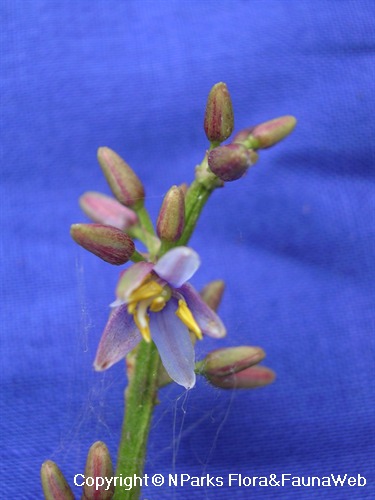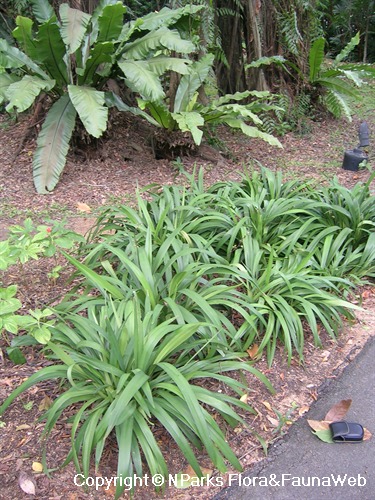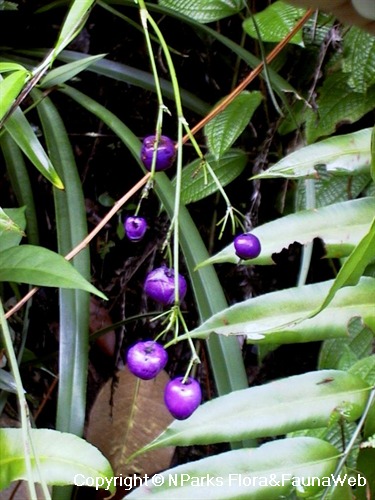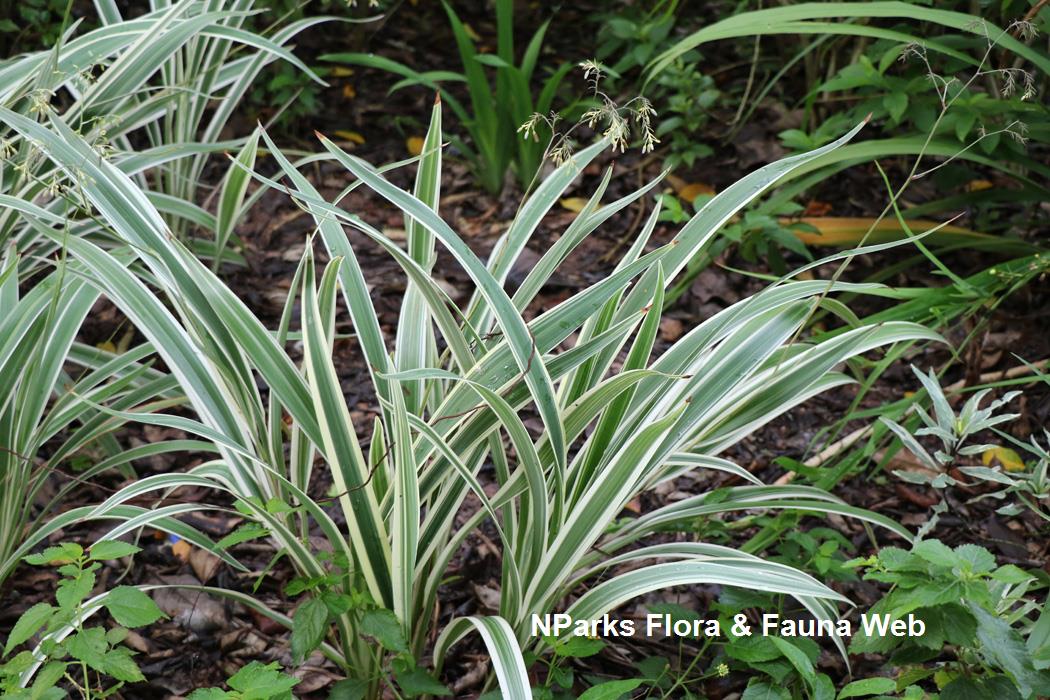
Back
Dianella caerulea
| Family Name: | Asphodelaceae |
| Synonyms: | Dianella angustifolia, Dianella elegans, Dianella paniculata |
| Common Name: | Paroo Lily, Flax Lily |
Name
Classifications and Characteristics
| Plant Growth Form | Shrub |
|---|---|
| Lifespan (in Singapore) | Perennial |
| Mode of Nutrition | Autotrophic |
Biogeography
| Native Distribution | Australia |
|---|---|
| Local Conservation Status | Non-native (Horticultural / Cultivated Only) |
Description and Ethnobotany
| Growth Form | A herbaceous perennial plant which grows to 1 m tall, has a thick, spreading underground rhizome and fibrous root system. |
|---|---|
| Foliage | Leaves are green, alternate arrangement, measuring 10 - 75 cm long and 0.5 - 2.5 cm wide, leaf sheath folded lengthwise (upper face is within), margin entire or serrated. |
| Flowers | Inflorescence, panicle, each panicle has 3 - 25 flowers; flower is star-shaped, has 6 petals, whitish blue to dark blue, stamens and anthers yellow, style and stigma white, ovary dark green and globose shaped. |
| Fruit | Fruits globose, measuring 8 - 15 mm in diameter, dark blue to indigo in colour. |
| Habitat | This species occurs in coastal shrubland, sandy area, open forest as well as woodlands. |
| Etymology | The genus name Dianella is the diminutive of 'Diana', the goddess of hunting. The specific epithet caerulea means blued or blue-tinged, which refers to the flower colour. |
| Ethnobotanical Uses | Edible Plant Parts : Edible Fruits, Edible Roots Food (Fruit or Vegetable): It was said that the fruits are eaten raw or cooked which gives nutty flavour. The roots are reported to be eaten after pounded and roasted. Medicinal: It has been reported that the ripe fruits are used to treat ulcers while the flower petals are used as ingredient for medicinal purposes. Others: The leaves are used to make decoration baskets and strings due to their strong silky fibre. |
Landscaping Features
| Landscaping | It is commonly grown in gardens. |
|---|---|
| Desirable Plant Features | Ornamental Foliage |
| Landscape Uses | Parks & Gardens, Small Gardens |
Plant Care and Propagation
| Light Preference | Semi-Shade |
|---|---|
| Water Preference | Moderate Water |
| Rootzone Tolerance | Drought Tolerant, Moist Soils, Well-Drained Soils |
| Propagation Method | Seed, Division |
Foliar
| Foliage Retention | Evergreen |
|---|---|
| Mature Foliage Colour(s) | Green |
| Foliar Type | Simple / Unifoliate |
| Foliar Arrangement Along Stem | Alternate |
| Foliar Shape(s) | Non-Palm Foliage |
| Foliar Margin | Entire, Serrulate |
| Leaf Area Index (LAI) for Green Plot Ratio | 3.5 (Shrub & Groundcover - Monocot) |
Floral (Angiosperm)
| Flower Colour(s) | Purple, Blue |
|---|---|
| Flower Grouping | Cluster / Inflorescence |
| Flower Symmetry | Radial |
| Individual Flower Shape | Stellate / Star-shaped |
| Inflorescence Type | Panicle |
Fruit, Seed and Spore
| Seed Description | Seeds ovoid shaped, measuring 4 mm by 2 mm. |
|---|
Image Repository
Others
| Master ID | 633 |
|---|---|
| Species ID | 1928 |
| Flora Disclaimer | The information in this website has been compiled from reliable sources, such as reference works on medicinal plants. It is not a substitute for medical advice or treatment and NParks does not purport to provide any medical advice. Readers should always consult his/her physician before using or consuming a plant for medicinal purposes. |




